Emerging Connections
Transitioning an In-Person Elementary STEM After-School Program to Distance Learning During COVID-19
Connected Science Learning March-April 2022 (Volume 4, Issue 2)
By Brooke McMahon, Jasmin Sanchez, Emma Case, Lindsay Huerta, W. Martin Kast, and Dieuwertje J. Kast
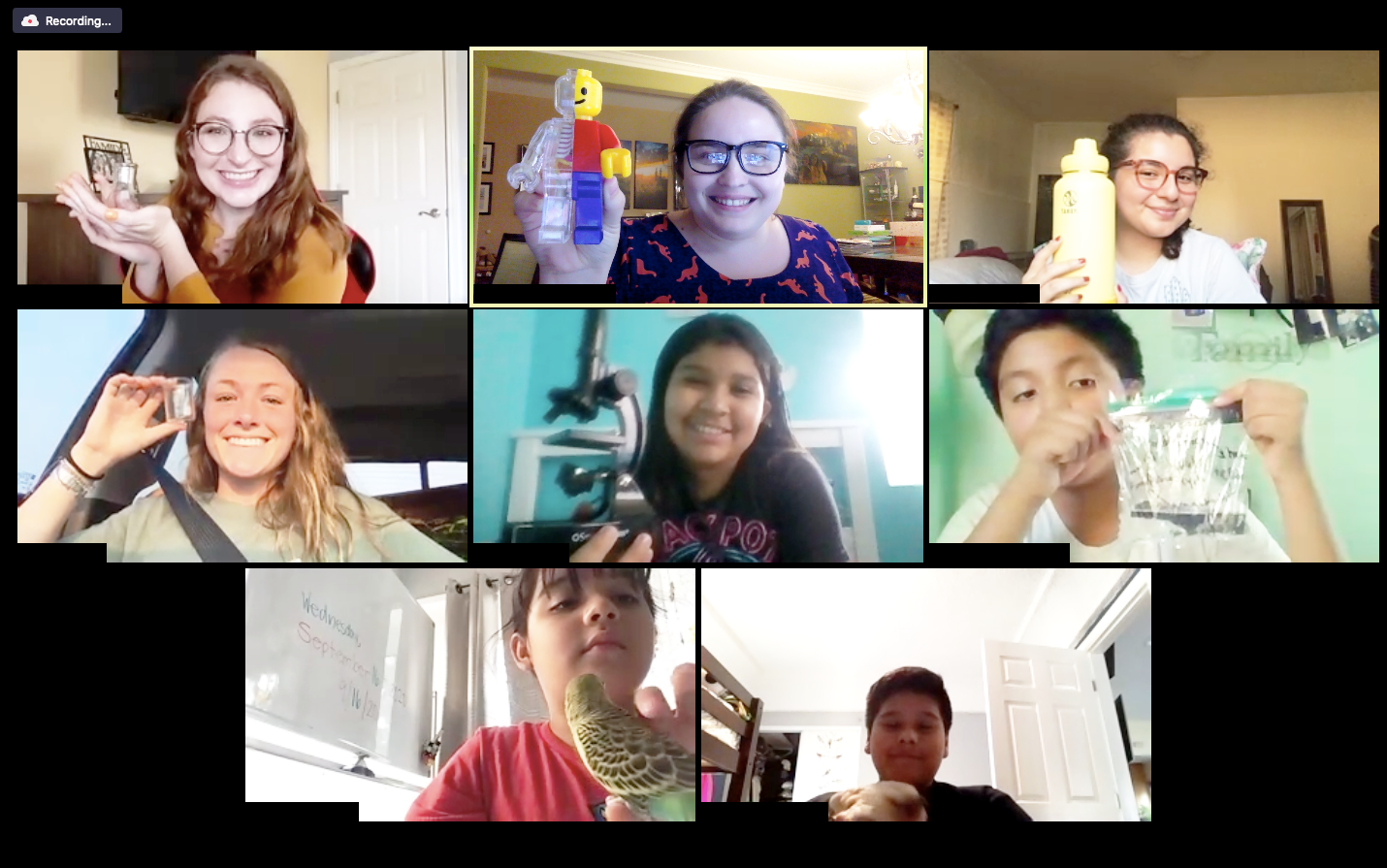
At the onset of COVID-19, after-school STEM programs faced the difficult challenge of transitioning to fully remote learning spaces. The WonderKids program—whose premise is built on in-person hands-on STEM learning about STEM careers, including in the cancer field—transitioned to the online environment. The new framework included the incorporation of simple, at-home science activities and presentations by Black, Indigenous, and people of color (BIPOC) STEM career speakers. Virtual learning has increased the program’s accessibility to STEM specialists and unique science spaces all over the world. This article highlights that all STEM programs can use at-home supplies and scientists in their community to create unique and exciting lessons. The transition of the WonderKids program provides a model for STEM education success in underserved communities and highlights the areas of virtual STEM learning that can be used in the transition back to in-person learning.
WonderKids Programming
The WonderKids Program was originally developed by the Joint Educational Project (JEP) at the University of Southern California (USC) in 2013 to support after-school programming in STEM (Science, Technology, Engineering and Mathematics). It was housed within a math and literacy program called ReadersPLUS which provided the infrastructure to facilitate after-school programming. The focus of WonderKids is to introduce a gamut of STEM fields to elementary audiences so students would know what type of STEM careers are available (see Figure 1). The goal of WonderKids is to present the concepts and principles of different STEM fields to increase student understanding. In addition, exposing students to scientists that hold similar identities to them shows students they too can become scientists.
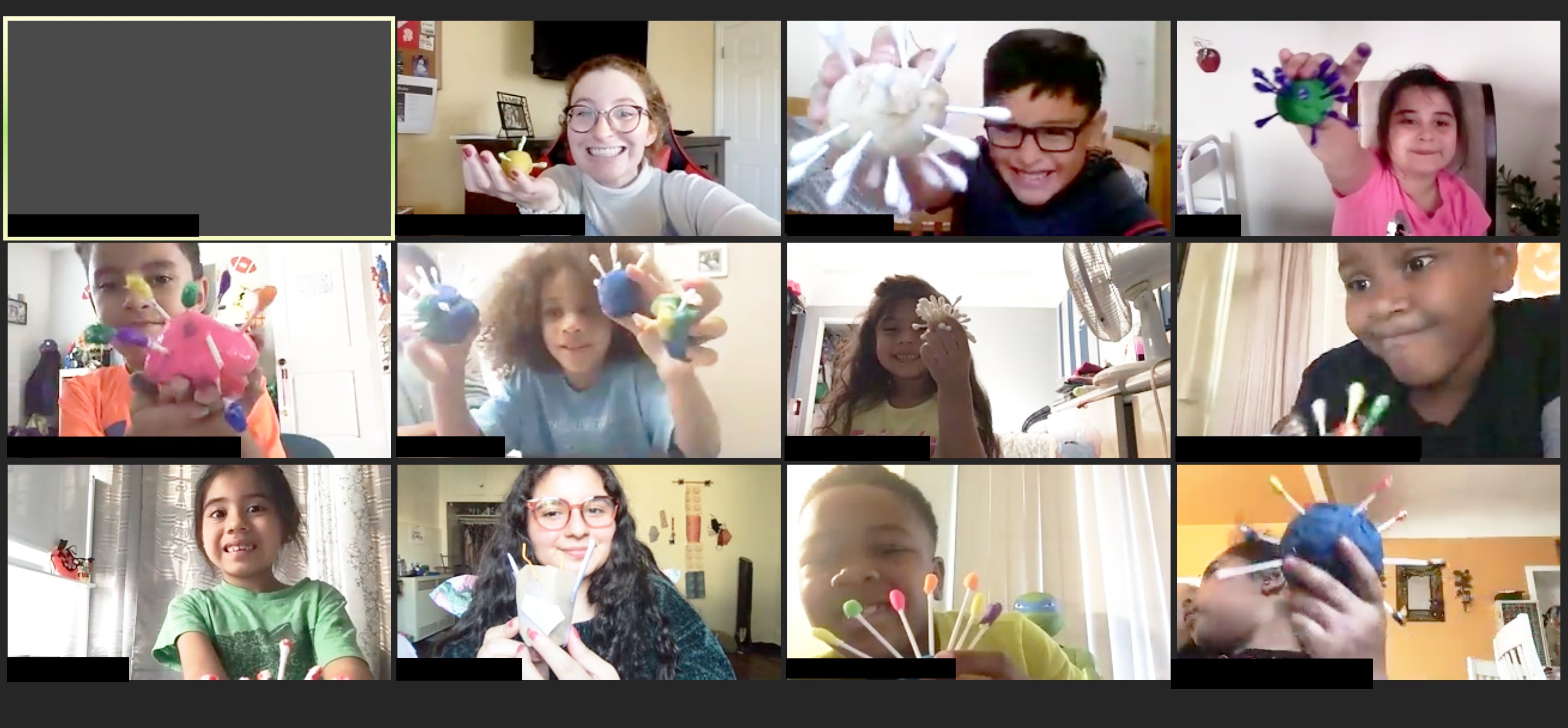
WonderKids is a unique program because it targets BIPOC populations and underrepresented minority (URM) (racially and socioeconomically) youth in the communities surrounding USC. Since spring 2018, the WonderKids curriculum has been presented to three Title 1 Los Angeles Unified School District (LAUSD) schools (Vermont Avenue Elementary, Lenicia B. Weemes Elementary School, and 32nd St./USC Visual and Performing Arts Magnet School). Title 1 status indicates that federal money is used to serve the academic needs of low-income students and their families. Students enrolled in these schools and in WonderKids are considered economically disenfranchised as well as racially and ethnically underrepresented in STEM careers. The students were signed up to take part in WonderKids through their teachers at their respective schools pre-COVID. The racial distribution of students enrolled in the three schools is 80.3% Latinx, 12.8% African American, and 0.1% American Indians or Alaska Native students (California Department of Education 2020). Ninety percent of the students in participating schools qualify for free or reduced-price lunch, which is a proxy for low socioeconomic status (California Department of Education 2020). On average, 41.4% of the students are English Language Learners (ELLs) and Spanish is the first language for approximately 97% of ELL students (California Department of Education 2020).
COVID-19 Program Design Changes
After the announcement of the California Stay-at-Home Order in spring 2020, all of JEP’s programs, including WonderKids, had to be restructured to accommodate the new distance learning environment, which also required a new chain of information distribution. JEP staff members would distribute program information to teachers at 15 of its partner schools and lastly, the teachers would distribute information to families in their classes. Families signed up their students through a Google Form (available in English and Spanish), providing WonderKids with essential information like age, grade, available technology, and ELL status that aided in placing and accommodating them in the virtual world. Approximately 60 students were enrolled in WonderKids during pre-COVID programming. During fall 2020 programming, approximately 15 students enrolled. WonderKids staff believe that the decline in enrollment could be a result of changing from paper to digital program information distribution, difficulties with access to technology, discomfort in the Zoom environment, and the lack of childcare for the virtual program.
During fall 2020 WonderKids expanded from its usual target audience of first through third graders to kindergarten through fifth grade. To accommodate the wider age range, students were split into cohorts: one section of grades K–2 students and one section of grades 3–5 students. By the beginning of WonderKids in fall 2020, LAUSD had distributed the technology needed for students to participate in their online school Zoom sessions. Students used the same devices to participate in the WonderKids live sessions. Enrollment increased from 15 students to 30 students during the spring semester, possibly because students, families, and teachers were more comfortable with the digital learning environment.
The original in-person WonderKids program took place over eight weeks with four STEM field modules; each module had four lessons taught over the course of two weeks. A STEM career speaker attended the last lesson of each STEM field module to share with students about their specialty and complete an activity with students. In fall 2020 we reconfigured WonderKids for the online environment to have six one-week modules (see Figure 2). In the last week of WonderKids, students presented a project to their peers and families on Zoom to demonstrate what they learned over the course of the program.
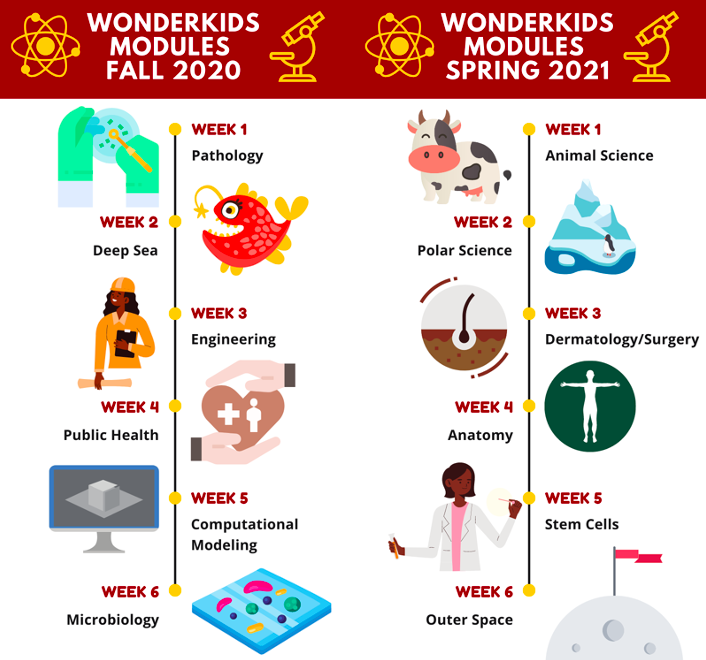
Module Framework
WonderKids’ modules are developed with the 5E Model (Engage, Explore, Explain, Elaborate, Evaluate) as inspiration (Duran and Duran 2004). Due to the program’s time constraints, it is difficult to implement all five stages of the 5E model. Because of this, WonderKids uses a modified 5E model to create modules emphasizing hands-on, inquiry-based practices and focusing on the Engage, Explore, and Explain phases of the 5E model. Modules involved two one-hour lessons over the course of two days per week. The modules were also designed with the science and engineering practices from the Next Generation Science Standards (NGSS) in mind, regularly engaging students in the practices of asking questions and defining problems, developing and using models, and planning and carrying out investigations (NGSS Lead States 2013). Using NGSS also helps align the content and skills learned in our after-school setting to in-school learning.
At the beginning of the first day, students complete a preassessment where they draw an image representing their ideas about the field of study being explored (see Figure 3). Students describe their drawing aloud for their peers and WonderKids instructors. Then, WonderKids instructors deliver a 15-minute lesson to share key vocabulary with the students. After, students complete a hands-on activity to explore the module’s topic.
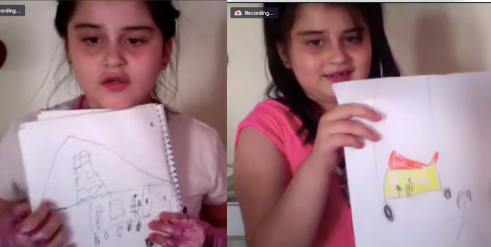
At the end of the first day, students develop a list of questions to ask the STEM career speaker during day 2 of the module. During the first session, staff members share their excitement for the upcoming speaker to encourage students to attend the second session.
WonderKids staff send weekly emails to families to encourage students’ continued participation and to help them prepare for hands-on learning by providing a supply list for easily accessible and safe materials for upcoming hands-on activities.
During the second day of the module, WonderKids staff either read a content-relevant book or lead students in a kinesthetic activity to help with focus during the STEM career speaker’s presentation. The speaker leads a lesson that includes personal information, their journey to becoming a scientist, a hands-on activity, and a question-and-answer section. When the speakers complete their lessons, students complete a postassessment to demonstrate what they learned (see Figure 3).
Speaker Selection and Training
A key feature of WonderKids is the scientists invited to serve as STEM career speakers. Interacting with these scientists provides an opportunity for students to build relationships and also see themselves as scientists. Because the majority of WonderKids students come from historically marginalized groups, BIPOC and women are highly prioritized as STEM career speakers (see Figure 4). Speakers highlight the unique, interesting features of their field; share their personal journeys; and together demonstrate a variety of career pathways (e.g., industry, academia, nonprofits, and more). Speakers for WonderKids are selected primarily through partnerships affiliated with JEP, which include many staff and faculty members at USC. Some speakers are found through online searches.
Wonderkids brings in speakers from all walks of life and STEM fields for its programming. We've had astronauts, cancer researchers, polar scientists, science Instagram influencers, and more! Our fall 2020 speakers included a computational scientist, marine biologist, cancer advocate, pathologist, cancer researcher, and an engineer. The spring 2021 speakers included an ocean educator, a polar educator and scientist, a science Instagram influencer, an anatomist, a stem cell researcher, and an astronaut.
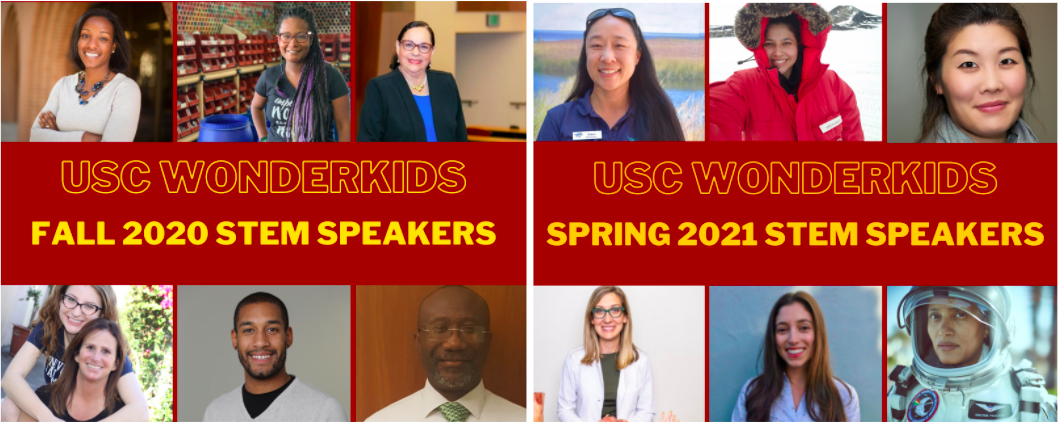
Not all of the speakers selected for WonderKids have a background educating elementary age students. Because of this, each speaker participates in a short one-on-one online training session with a WonderKids staff member. In this training session, the speaker’s research, work experience, interests, and education journey are discussed. This helps the speaker and WonderKids staff member develop ideas for the hands-on activity and mini-lesson. Speakers are provided with tips for making their work and life experiences more accessible for young students; this includes helping the speaker develop metaphors, animations, and anecdotes to make the lesson exciting and comprehensible. The modules are designed in collaboration with the speaker, which also helps the staff member ensure students are prepared when they meet the speaker. WonderKids staff members also support speakers by providing demographic and behavioral information about the students, outlines for the speaking engagement, and additional advice for engaging elementary students, as well as creating additional instructional materials.
Example Module
During the engineering module, WonderKids students explored principles of engineering as well as the engineering design process. The engineering module also had the most consistent attendance and thus yielded the most data for program evaluation, described below. On the first day of the module, before the lesson started, WonderKids students were asked “What is engineering?” and invited to create a drawing in response. The students then shared and described their drawings for the class. After this pretest, students engaged in USC’s Science outreach program (SCout) lesson about the principles of engineering through a lesson about the forces that are exerted on an aircraft as it flies. The lesson included essential vocabulary like thrust, drag, lift, and weight as well as strategies for building paper airplanes, which served as an introduction for the second day of the engineering module.
On the second day, STEM career speaker Dr. Darin Gray, the co-director of the USC Viterbi K-12 STEM Center, joined Wonderkids students. He led students through the engineering design process as they created, tested, and redesigned paper airplanes (see Figure 5). Students shared their prototypes to illustrate how engineers engage in the design process. After completing the lesson, students completed a post-assessment where they were again asked “What is engineering?” Students drew pictures and provided verbal responses to answer the post-assessment, which allowed Wonderkids staff to see how students’ ideas about engineering changed as a result of the module.
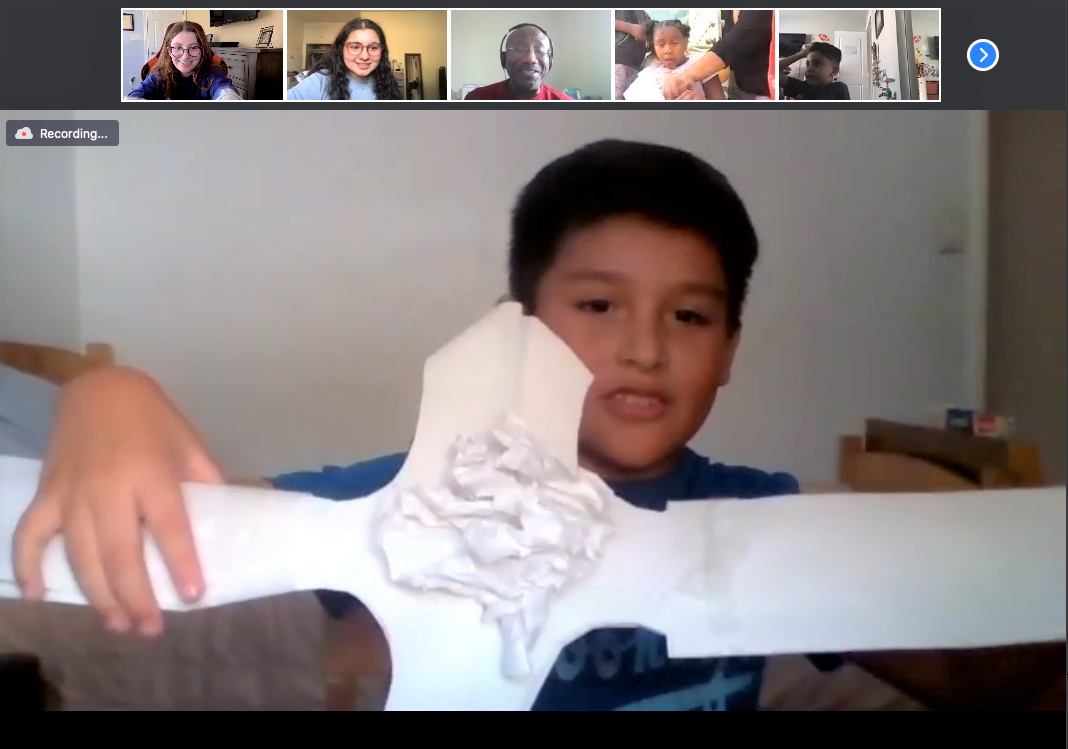
Data From the Program
The primary assessment data came from the pre and post drawings created by the students. Due to low literacy rates, it was difficult to have students write answers to questions or type in the chat feature of Zoom. This style of assessment means that students who shared later could have a potential advantage. Wonderkids staff compared each student’s pre and post drawings and what they said about them to determine any change in students’ understanding of engineering. An improved understanding was evaluated by having post-drawings that were more closely aligned with engineering, explanations that included elements of the engineering design process, and explanations that had more technical language.
Attendance was most consistent for the engineering module, and thus we will consider student pre/post data for that module here. Unfortunately, student absences and the short module length made it difficult to draw conclusions from much of the pre/post data we collected. For the engineering module, 83.3% of students showed an improved understanding of engineering (Figure 6).
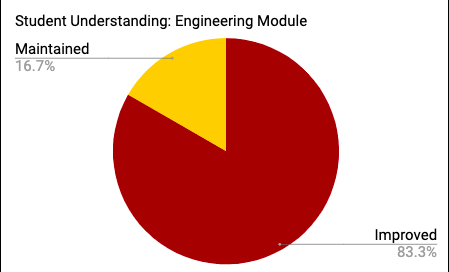
The WonderKids staff considered using standardized surveys to assess student knowledge, but content covered in the program is too niche for generic surveys to apply. In the future, WonderKids staff would like to focus on improving the program's data collection methods for distance learning. One idea that could improve assessment is to place students in breakout rooms with a WonderKids instructor to reduce the amount of time the assessment takes and could prevent other students from having an advantage by gaining information from their peers.
Family feedback has been the most significant measure of success for WonderKids. Families were given a Google Form (in English and Spanish) and asked to evaluate the program. Ninety percent of families said that they had observed their student asking questions and 70% responded saying that their student shared with them something that they learned (see Figure 7). Families also had the opportunity to share narrative feedback. One parent shared “my daughter had expressed what she learned about body parts, foods, diseases, and the scientists that work in that field. I feel that it has opened up her mind about science.” Another parent noted that their child “is more aware of viruses and bacteria and how washing his hands is important.”

The STEM career speakers that participated in WonderKids also provided feedback on their experience with the program. The STEM speakers felt that they were prepared and the students had sufficient background knowledge for the lesson they presented. After working with WonderKids, one of the speakers shared, “the team is supportive, knowledgeable, and caring. This combination makes it easy on the speaker to lead a STEM activity.” This praise was also echoed by another speaker, who said, “I enjoyed participating in WonderKids and the kids seemed engaged.”
The authors acknowledge the difficulties of evaluating the success of the program due to small sample sizes from the student assessments, parent survey, and speaker survey.
Lessons Learned
Distance learning has forced WonderKids educators to use new strategies that will be taken back to an in-person learning environment. The transition to an online environment due to COVID-19 has resulted in many lessons learned, including:
- Hands-on activities are still possible in a virtual learning environment. Creating such lessons requires being mindful of student and family resources as well as student safety. WonderKids staff emailed families two to three days beforehand to inform them of supplies students would need. These emails also informed families of the tasks their students would be completing—giving parents/guardians an opportunity to decline consent for any activity if they chose. If students came without materials, instructors needed to have the supplies to provide a demonstration. Each week approximately one to two students would come to class without materials.
- Distance learning has expanded access to STEM speakers because specialists all over the world can now join the classroom and share their knowledge with students. A virtual learning environment allows for greater access to STEM career speakers and the spaces in which they work compared with in-person programming. The ease of using Zoom made it easier for speakers to participate and also allowed us to work with scientists outside of Southern California. Remote learning also gave students access to unique environments by participating in virtual lab tours that would typically be unaccessible due to lab safety protocols and age restrictions. When STEM programs return to in-person learning, we plan to continue to use technology to access scientists and the unique spaces in which they work.
- Virtual out-of-school programming can help reduce student learning loss resulting from the pandemic. Learning loss, or lack of learning growth, has been more prominent in underserved BIPOC communities. This is likely due to restricted access to high-quality technology and distance learning settings that are not optimized learning environments (McKinsey and Company 2020). Because WonderKids provides programs for the underserved BIPOC communities surrounding USC, the programs have created more opportunities for learning growth.
- Communicating with parents was an essential aspect of distance learning and the communication strategies will continue to be used in the future and be incorporated more significantly when the program returns to in-person settings.
While there have been positive lessons learned, issues of access and equity, literacy rates, and assessments are areas that require growth. The digital divide and poor technology disproportionally impact the underserved communities reached by Wonderkids. Some students have difficulties with their devices like bad microphones and slow internet speeds. Low literacy rates mean that some students are unable to communicate using Zoom’s chat function. New devices and as well as more local hotspots to improve internet connections are required to address this challenge. We are also considering how to support literacy skill development by including more reading and writing opportunities within the modules. Lastly, we are also considering strategies for collecting more useful program evaluation data, for example, using breakout rooms to give students the opportunity to share in more private settings could mitigate this issue of students adjusting their description of their pictures based on what other students said. While drawing conclusions from the data has been difficult, using art and verbal descriptions has helped WonderKids students communicate their ideas without having to be concerned about their ability to write in English. When we return to in-person learning, WonderKids will continue to incorporate drawing in the pre- and postassessments but will most likely collect worksheets opposed to having students share their responses aloud.
Conclusion
Integrating hands-on activities, STEM speakers, and virtual learning technology can promote science learning in any community. Virtual learning has created opportunities where BIPOC students have access to scientists from their community and beyond. While WonderKids’ example is specific to the Los Angeles community and features speakers primarily from Southern California, this model can be incorporated into formal and informal educational institutions in any location. Complex content—such as engineering, computational modeling, microbiology, and pathology—does not need to be off-limits for younger students at the elementary level. This content is essential for students in underserved groups as it exposes them to a variety of scientific fields, develops career awareness, and encourages them to advance their education and enter careers in science.
Acknowledgments
Thank you to USC Norris Comprehensive Cancer Center for supporting WonderKids, USC Joint Educational Project for housing WonderKids, and USC Good Neighbors Campaign for additional funding of WonderKids. Thank you to Dr. Susan Harris and Kathrin Altmann for editing our manuscript. We’d like to give a special thank you to our speakers for Wonderkids during the 2020–2021 year including: Fall 2020 speakers: Stacey Finley, Dijanna Figueroa, Lourdes Baezconde-Garbanati, Martha McMahon, DJ Fernandez, and Darin Gray, and spring 2021 speakers: Staci Wong, Jocelyn Argueta, Jessica So, Jamie Decker, Tal Rosen, and Sian Proctor.
Dieuwertje Kast (dkast@usc.edu) is the Director of STEM Education Programs, Brooke McMahon is a STEM instructor, Jasmin Sanchez is a STEM instructor, Emma Case is a STEM instructor, Lindsay Huerta is a STEM instructor, all at the University of Southern California Dana and David Dornsife College of Letters Arts and Sciences – Joint Educational Project, Los Angeles, California. W. Martin Kast is the Director of K–12 URM Cancer Education Program at University of Southern California - Norris Comprehensive Cancer Center, Los Angeles, California.
citation: McMahon, B., J. Sanchez, E. Case, L. Huerta, W.M. Kast, and D.J. Kast. 2022. Transitioning an in-person elementary stem after-school program to distance learning during COVID-19. Connected Science Learning 4 (2). https://www.nsta.org/connected-science-learning/connected-science-learning-march-april-2022/transitioning-person
Equity NGSS Three-Dimensional Learning Elementary Informal Education


